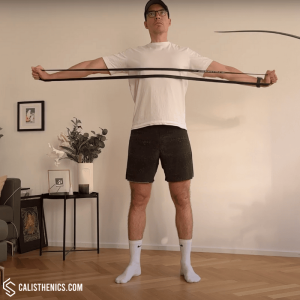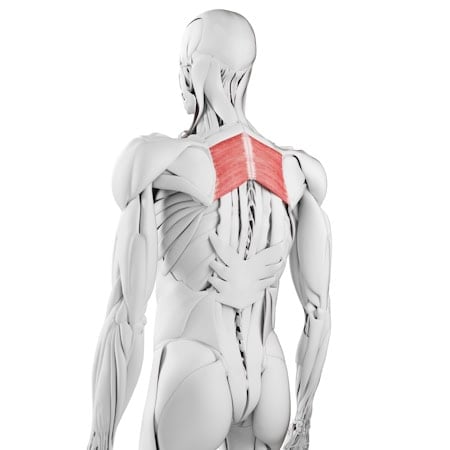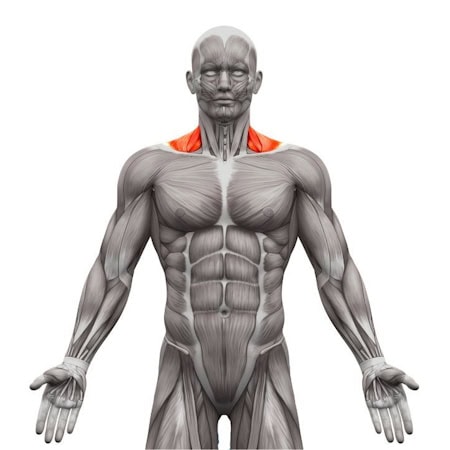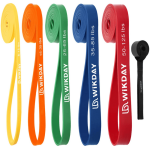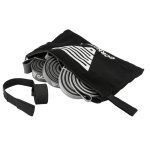Resistance Band Pull-Aparts
How to do Resistance Band Pull-Aparts?
Resistance band pull-aparts are a highly effective upper-body exercise that primarily targets the muscles of the upper back, shoulders, and chest. Using a resistance band, this movement mimics the pulling motion of rows or reverse flys, helping to strengthen the muscles responsible for scapular retraction and shoulder stability. Resistance band pull-aparts are an excellent exercise for improving posture, shoulder mobility, and overall upper-body strength, making them a great addition to any fitness routine, especially as a warm-up or corrective exercise.
Steps to Perform a Proper Resistance Band Pull-Apart:
1. Set Up with the Resistance Band:
• Stand with your feet hip-width apart, holding a resistance band with both hands. Your arms should be extended straight in front of you at shoulder height.
• Your grip on the band should be shoulder-width apart or slightly wider, depending on your strength and the band’s resistance.
2. Engage Your Core and Upper Back:
• Engage your core by pulling your belly button toward your spine to maintain a neutral spine.
• Stand tall with your shoulders back and down, keeping your chest lifted.
3. Pull the Band Apart:
• Exhale as you pull the band apart by moving your arms outward to the sides. Focus on squeezing your shoulder blades together as you pull, engaging the muscles of the upper back.
• Keep your arms straight throughout the movement, but avoid locking your elbows.
• The band should stretch across your chest as you pull, and your hands should move out to the sides of your body, level with your shoulders.
4. Return to Starting Position:
• Inhale as you slowly return your arms to the starting position in front of you, maintaining control of the band’s resistance.
• Keep tension in your upper back and shoulders as you return to the starting position, avoiding a sudden snap of the band.
5. Repeat the Movement:
• Perform the desired number of repetitions, focusing on smooth, controlled movements and consistent muscle engagement throughout the exercise.
Benefits of Resistance Band Pull-Aparts
• Strengthens the Upper Back and Shoulders: Resistance band pull-aparts primarily target the rhomboids, rear deltoids, and trapezius, helping to build strength in the muscles responsible for scapular retraction and shoulder stability.
• Improves Posture: By strengthening the muscles of the upper back, resistance band pull-aparts can help counteract the effects of poor posture caused by sitting or slouching, improving spinal alignment and shoulder positioning.
• Increases Shoulder Mobility: This exercise enhances shoulder mobility and flexibility, particularly in the scapula, which is essential for healthy shoulder function.
• Enhances Shoulder Stability: Strengthening the muscles around the shoulder joint, particularly the rotator cuff and rear deltoids, improves shoulder stability and reduces the risk of injury.
• Corrects Muscle Imbalances: Resistance band pull-aparts help correct imbalances between the front and back of the body, particularly in individuals who perform a lot of pushing or chest exercises.
• Accessible and Portable: All you need for this exercise is a resistance band, making it an easy and portable movement to include in your workouts at home, the gym, or while traveling.
• Great for Warm-Ups or Rehabilitation: Resistance band pull-aparts are an excellent exercise for warming up the shoulders and upper back before a workout or for rehabilitating shoulder injuries, as they promote controlled, low-impact movement.
Common Mistakes to Avoid
• Arching the Back: Avoid arching your lower back as you pull the band apart. Keep your core engaged to maintain a neutral spine throughout the exercise.
• Using Momentum: Don’t jerk the band or use momentum to pull it apart. Focus on slow, controlled movements to maximize muscle engagement and avoid injury.
• Letting the Shoulder Blades Stay Forward: Make sure to actively retract your shoulder blades as you pull the band apart. Failing to do so will reduce the effectiveness of the exercise.
• Shrugging the Shoulders: Avoid letting your shoulders rise toward your ears as you pull the band. Keep your shoulders down and back to engage the correct muscles.
• Overextending the Arms: Do not overextend or hyperextend your arms behind you, which can put unnecessary stress on the shoulder joints. Keep the movement within a comfortable range of motion.
Tips for the proper execution of Resistance Band Pull-Aparts
Squeeze Your Shoulder Blades: Focus on squeezing your shoulder blades together as you pull the band apart. This ensures that you engage the muscles of your upper back effectively.
Keep Arms Straight but Not Locked: Maintain straight arms during the movement, but avoid locking your elbows to protect your joints and maximize muscle engagement.
Core Engagement: Keep your core tight to prevent arching your back as you pull the band apart. A stable core helps maintain proper posture and prevents compensations.
Controlled Movement: Perform the movement slowly and with control, both when pulling the band apart and when returning to the starting position. Avoid jerking or using momentum.
Breathing: Exhale as you pull the band apart and inhale as you return to the starting position. Proper breathing helps maintain focus and control.
Muscles worked when doing Resistance Band Pull-Aparts
Primary Muscles:
•Rhomboids: Located between the shoulder blades, the rhomboids are responsible for retracting the scapula, helping to squeeze the shoulder blades together during the pull-apart.
•Rear Deltoids: The rear part of the shoulders (posterior deltoids) is heavily engaged to control the backward movement of the arms.
•Trapezius: The middle and lower trapezius muscles stabilize the scapula and assist in pulling the shoulder blades together.
Secondary Muscles:
•Shoulders: The deltoid muscles, particularly the posterior deltoids, are engaged to stabilize and control the movement of the arms.
•Rotator Cuff: The muscles of the rotator cuff help stabilize the shoulder joint throughout the exercise.
•Core: The abdominals and lower back muscles stabilize the torso and prevent compensations during the movement.
•Biceps: Assist in controlling arm movement and stabilizing the arms as they move through the range of motion.
Primary Muscle(s):
Secondary Muscle(s):
Adjust the difficulty of Resistance Band Pull-Aparts
How to make Resistance Band Pull-Aparts harder?
How to make Resistance Band Pull-Aparts easier?
How to make Resistance Band Pull-Aparts harder?
To make Resistance Band Pull-Aparts harder:
-
Use a Heavier Resistance Band: Switch to a band with more resistance to increase the intensity and challenge your upper back and shoulder muscles further.
-
Narrow Your Grip: Narrow your hand placement on the band to increase the resistance, making the exercise more difficult.
-
Increase Repetitions or Sets: Perform more repetitions (e.g., 15-20) or add extra sets to further challenge your upper body endurance.
-
Hold the Contraction: Pause at the end of the pull for 2-3 seconds, squeezing your shoulder blades together to increase time under tension and engage your muscles more deeply.
How to make Resistance Band Pull-Aparts easier?
To make Resistance Band Pull-Aparts easier:
-
Use a Lighter Resistance Band: Start with a lighter resistance band that provides less tension, making it easier to perform the pull-apart while maintaining proper form.
-
Widen Your Grip: Widen your hand placement on the band to reduce the tension, making the exercise easier to perform.
-
Perform Fewer Repetitions: Start with fewer repetitions (e.g., 8-10) and gradually increase as your strength improves.

